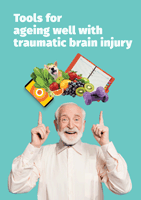Collaboration, Co-production, & Co-design: Moving Ahead in Brain Impairment
This paper describes a six-stage co-design process drawing on a co-design group made up of people with acquired brain injury, practicing health professionals and researchers, and injury and disability insurers. This work was coupled with large stakeholder engagement across three online health professional workshops and one in-person workshop. The resulting co-produced Framework for Evaluation of Assistive Technology is now available for use by health professionals and people with acquired brain injury via a free website, called My Technology Space.
This article belongs to the collection: Collaboration, Co-production, & Co-design: Moving Ahead in Brain Impairment.
In peer support, a working alliance – or collaborative relationship between mentor and mentee – facilitates better health outcomes for participants. Our study aimed to examine working alliances in traumatic brain injury peer support; findings indicated working alliance is facilitated through conversations that validate an individual’s experiences of traumatic brain injury, and personal growth in self-acceptance and hope of both the peer support receiver and worker. Findings inform traumatic brain injury peer support programs of key design considerations to increase working alliance.
This article belongs to the collection: Collaboration, Co-production, & Co-design: Moving Ahead in Brain Impairment.
Peer support programs can help people with brain injury, but the program needs to have a structure to work well. This study tested a peer support program for those living with brain injury, and found the program could bring people in, maintain high attendance and coordinate resources proficiently. The peer support program achieved some positive outcomes for the three participants in this study. Future research is needed with more participants to evaluate the benefits of peer support.
This article belongs to the collection: Collaboration, Co-production, & Co-design: Moving Ahead in Brain Impairment.
Primary progressive aphasia (PPA) describes a group of language-led dementias for which the main treatment is speech and language therapy. Six stages of PPA have been described by Hardy et al. 2024a, 2024b, reflecting a verbal and non-verbal symptoms that progress inexorably over time. Informed by the People with Aphasia and Other Layperson Involvement framework for guiding patient and public involvement in aphasia research, this study used World Café and survey methods to co-produce a care pathway for PPA.
This article belongs to the collection: Collaboration, Co-production, & Co-design: Moving Ahead in Brain Impairment.
The article describes the process of developing a smart device application (app) for people with acquired brain injury. The app was developed through a series of workshops that involved people with acquired brain injury, their support people, health professionals who work in acquired brain injury rehabilitation, technology designers and the research team. Learnings from the process are outlined, including recommendations for people who wish to use this approach in the future.
This article belongs to the collection: Collaboration, Co-production, & Co-design: Moving Ahead in Brain Impairment.
The aim of this study was to explore computer-mediated communication (CMC) use among adolescents with acquired brain injury (ABI) by co-designing the Social Media Building Blocks (SMBB) survey. Guided by the Double Diamond (DD) Framework, project team members, including youth with ABI, collaboratively developed and refined the survey. Results showed strong engagement among team members with the co-design process. The study highlights the value of co-design frameworks in fostering meaningful participation among various interest-holders in rehabilitation research.
This article belongs to the collection: Collaboration, Co-production, & Co-design: Moving Ahead in Brain Impairment.
A literature review was conducted to better understand when and how adults with acquired neurological disability collaborate with health professionals and researchers in co-design. We also wanted to understand the experience of participating in co-design. Forty-five studies were identified. Analysis of the studies showed variability in the definition and use of co-design, and despite being unfamiliar and at times challenging, it was a meaningful experience. Future work is needed to optimise involvement of people with disability in co-design.
This article belongs to the collection: Collaboration, Co-production, & Co-design: Moving Ahead in Brain Impairment.
Today’s world increasingly relies on technology, but not all groups can easily shape the tools they use. We explored a new type of collaborative online design event that allowed older adults and people living with neurological conditions to meaningfully contribute to technology development, unlike traditional hackathons. By finding ways to include meaningful contribution from people with diverse needs, we can help ensure future technologies truly meet everyone’s needs.
This article belongs to the collection: Collaboration, Co-production, & Co-design: Moving Ahead in Brain Impairment.
Including people with lived experience of brain injury in the development of a new therapy can ensure the end-product meets the needs of future users more effectively. We worked with people with communication difficulties following traumatic brain injury, and their families, to co-design a family therapy. The people taking part gave positive feedback about being involved in the research and identified ways in which the therapy could be improved. For example, making the content person-centred and easy to understand.
This article belongs to the collection: Collaboration, Co-production, & Co-design: Moving Ahead in Brain Impairment.
Despite their complex health needs, there are limited targeted resources to assist people with traumatic brain injury to age well. This study used co-design and co-production methods within a five-stage design-thinking process to develop a new resource called ‘Tools for ageing well with traumatic brain injury’. This resource will help people with brain injury and their families/carers to proactively plan for ageing well with traumatic brain injury. Image credit Ingrid Hopper using adapted photograph by Roman Samborskyi/Shutterstock.com.
This article belongs to the collection: Collaboration, Co-production, & Co-design: Moving Ahead in Brain Impairment.



